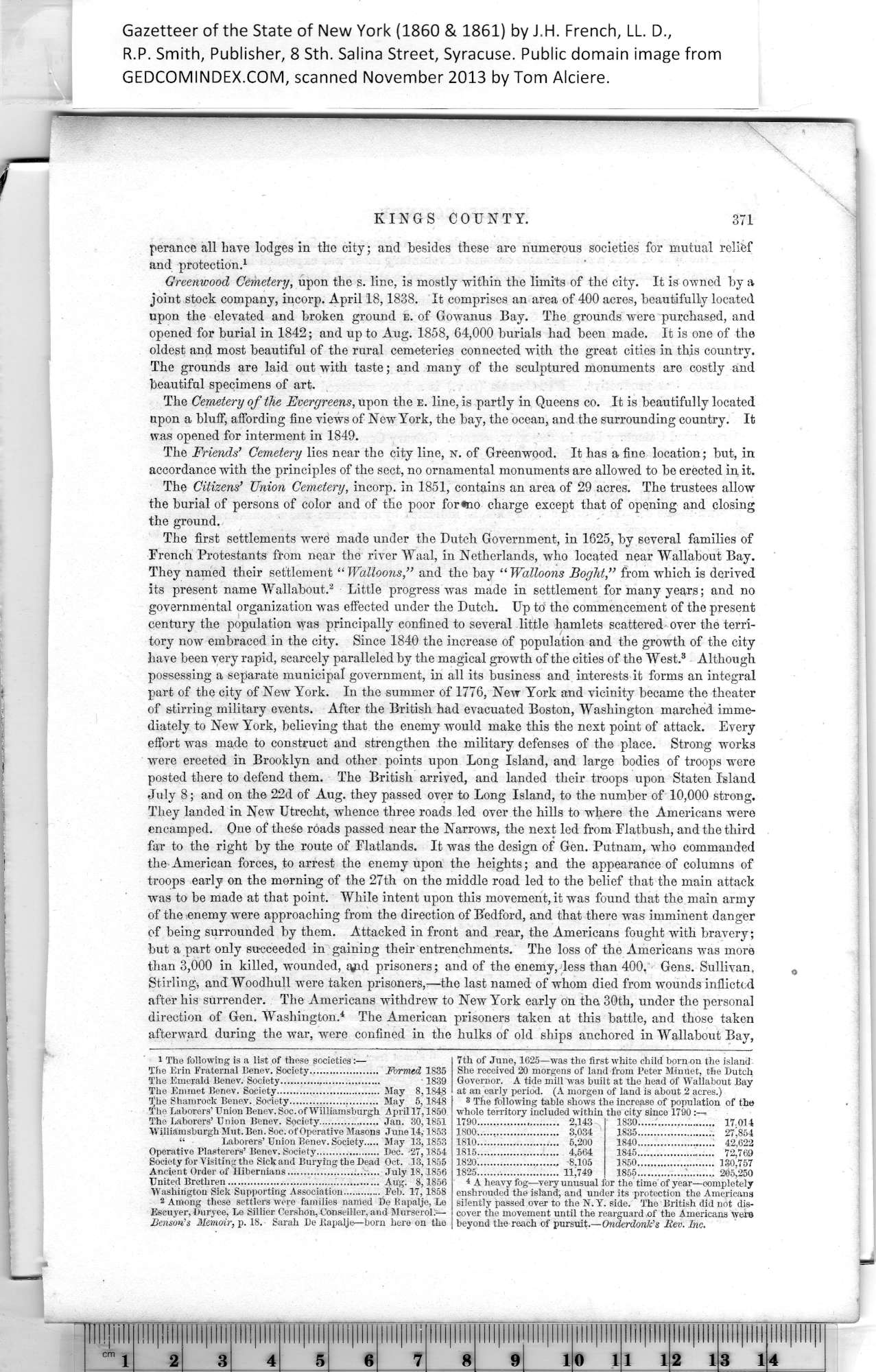|
KINGS COUNTY. 371
perance all have lodges in the city; and besides these are numerous societies for mutual relifef
and protection.1
Greenwood Cemetery, upon the s. line, is mostly within the limits of the city. It is owned by a
joint stock company, incorp. April 18,1838. It comprises an area of 400 acres, beautifully located
upon the elevated and broken ground e. of Gowanus Bay. The grounds were purchased, and
opened for burial in 1842; and up to Aug. 1858, 64,000 burials had been made. It is one of the
oldest and most beautiful of the rural cemeteries connected with the great cities in this country.
The grounds are laid out with taste; and many of the sculptured monuments are costly and
beautiful specimens of art.
The Cemetery of the Evergreens, upon the e. line, is partly in Queens co. It is beautifully located
upon a bluff, affording fine views of New York, the bay, the ocean, and the surrounding country. It
was opened for interment in 1849.
The Friends’ Cemetery lies near the city line, n. of Greenwood. It has a fine location; but, in
accordance with the principles of the sect, no ornamental monuments are allowed to be erected in it.
The Citizens’ Union Cemetery, incorp. in 1851, contains an area of 29 acres. The trustees allow
the burial of persons of color and of the poor for«no charge except that of opening and closing
the ground.
The first settlements were made under the Dutch Government, in 1625, by several families of
French Protestants from near the river Waal, in Netherlands, who located near Wallabout Bay.
They named their settlement “ Walloons,” and the bay “ Walloons Boght,” from which is derived
its present name Wallabout.2 Little progress was made in settlement for many years; and no
governmental organization was effected under the Dutch. Up to the commencement of the present
century the population was principally confined to several little hamlets scattered over the terri¬
tory now embraced in the city. Since 1840 the increase of population and the growth of the city
have been very rapid, scarcely paralleled by the magical growth of the cities of the West.3 Although
possessing a separate municipal government, in all its business and interests it forms an integral
part of the city of New York. In the summer of 1776, New York and vicinity became the theater
of stirring military events. After the British had evacuated Boston, Washington marched imme¬
diately to New York, believing that the enemy would make this the next point of attack. Every
effort was made to construct and strengthen the military defenses of the place. Strong works
were erected in Brooklyn and other points upon Long Island, and large bodies of troops were
posted there to defend them. The British arrived, and landed their troops upon Staten Island
July 8; and on the 22d of Aug. they passed over to Long Island, to the number of 10,000 strong.
They landed in New Utrecht, whence three roads led over the hills to where the Americans were
encamped. One of these roads passed near the Narrows, the next led from Flatbush, and the third
far to the right by the route of Flatlands. It was the design of Gen. Putnam, who commanded
the American forces, to arrest the enemy upon the heights; and the appearance of columns of
troops early on the morning of the 27th on the middle road led to the belief that the main attack
was to be made at that point. While intent upon this movement, it was found that the main army
of the enemy were approaching from the direction of Bedford, and that there was imminent danger
of being surrounded by them. Attacked in front and rear, the Americans fought with bravery;
but a part only succeeded in gaining their entrenchments. The loss of the Americans was more
than 3,000 in killed, wounded, tyid prisoners; and of the enemy, less than 400, Gens. Sullivan,
Stirling, and Woodhull were taken prisoners,—the last named of whom died from wounds inflicted
after his surrender. The Americans withdrew to New York early on the 30th, under the personal
direction of Gen. Washington.4 The American prisoners taken at this battle, and those taken
afterward during the war, were confined in the hulks of old ships anchored in Wallabout Bay,
7th of June, 1625—was the first white child born on the island.
She received 20 morgens of land from Peter Minuet, the Dutch
Governor. A tide mill was built at the head of Wallabout Bay
at an early period. (A morgen of land is about 2 acres.)
3 The following table shows the increase of population of the
whole territory included within the city since 1790
1830...... 17.014
1835........................ 27,854
1840....................... 42,622
1845................. 72,769
1850........................ 130,757
1855..............:......... 205,250
i A heavy fog—very unusual for the time'of year—completely
enshrouded the island, and under its protection the Americans
silently passed over to the N. Y. side. The British did not dis¬
cover the movement until the rearguard of the Americans were
beyond the reach of pursuit.—Onderdonk’s Rev. Inc.
1
The following is a list of these societies:—
The Erin Fraternal Benev. Society..................... Formed 1835
The Emerald Benev. Society............ ■ 1839
The Emmet Benev. Society................................ May 8,1848
l)he Shamrock Benev. Society.................,......... May 5,1848
tfhe Laborers’ Union Benev. Soc. of Williamsburgh April 17,1850
The Laborers’ Union Benev. Society................... Jan. 30,1851
Williamsburgh Mut. Ben. Soc. of Operative Masons June 14,1853
“ Laborers’ Union Benev. Society May 13,1853
Operative Plasterers’ Benev. Society.................... Bee. -27,1854
Society for Visiting the Sick and Burying the Dead Oct. 13,1855
Ancient Order of Hibernians............................ July 18,1856
United Brethren............................................... Aug. 8,1856
Washington Sick Supporting Association............. Feb. 17,1858
2
Among these settlers were families named De Kapalje, Le
3
Escuyer, Duryee, Le Sillier Cershon, Conseiller, and Murserol.-—
4
Benson's Memoir, p. 18. Sarah De Rapalje—horn here on the
| 